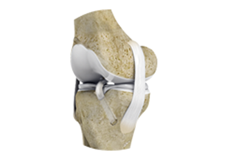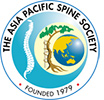What is All-Inside ACL Reconstruction with Allograft?

The all-inside ACL reconstruction with allograft is a novel surgical technique used to treat anterior cruciate ligament (ACL) tears. The procedure involves the replacement of a torn or damaged ACL ligament in your knee with a new ACL tissue graft obtained from a deceased donor (allograft). The most common allografts used are the patellar tendon (tendon of the kneecap) or one of the hamstring tendons (tendons located at the back of the thigh). In some instances, the quadriceps tendon located above the kneecap is used.
The all-inside ACL reconstruction with the allograft technique creates bone sockets for ACL graft passage, as opposed to more traditional full bone tunnels, and typically incorporates suspensory fixation instead of screw fixation to secure the graft. Advantages of this novel technique over traditional ACL reconstruction techniques include:
- Decreased postoperative pain and swelling
- Minimal hardware
- Decreased bone removal
- Smaller skin incisions
- Appropriate graft tensioning and re-tensioning
- Circumferential graft to bone healing
- Anatomic tunnel/socket placement
- Faster recovery
- Shorter rehabilitation
ACL tears most often occur during sports activities that involve pivoting, cutting, and turning movements as in football, soccer, skiing, tennis, and basketball. The benefits of all-inside ACL reconstruction are especially valuable for athletes or individuals with an active lifestyle. In the past, an ACL tear could ruin an athlete’s career. However, thanks to the improvements provided by this procedure, physically active individuals can return to their lifestyle with minimal recovery time and less pain.
Anatomy of the ACL
The anterior cruciate ligament is one of the four major ligaments of the knee that connects the femur (thighbone) to the tibia (shinbone) and helps stabilise your knee joint. It prevents excessive forward movement of the tibia in relation to the femur as well as limiting rotational movement of the knee. When this ligament tears, unfortunately, it does not heal on its own and often leads to the feeling of instability in the knee, requiring reconstruction to correct the abnormality.
Indications for All-Inside ACL Reconstruction with Allograft
The all-inside ACL reconstruction surgery with allograft is typically indicated for ACL tears. An ACL tear is a sports-related injury that occurs when the knee is forcefully twisted or hyper-extended. It usually occurs with an abrupt directional change with the foot fixed on the ground or when the deceleration force crosses the knee. Sudden directional change while running, sudden slowing down while running, landing incorrectly from a jump, and direct blow to the side of your knee, such as during a football tackle can result in ACL tear or injury.
Preparation for All-Inside ACL Reconstruction with Allograft
In general, preparation for all-inside ACL reconstruction surgery will involve the following steps:
- A review of your medical history and a physical examination are performed to check for any medical issues that need to be addressed prior to surgery.
- You may need to undergo tests such as blood work and imaging to help detect any abnormalities that could compromise the safety of the procedure.
- You will be asked if you have allergies to medications, anaesthesia, or latex.
- You should inform your doctor of any medications or supplements you are taking or any conditions you have such as heart or lung disease.
- You may be asked to stop taking certain medications, such as blood thinners, anti-inflammatories, aspirin, or other supplements for a week or two.
- You should refrain from alcohol and tobacco at least a few days prior to surgery and several weeks after, as it can hinder the healing process.
- You should not consume any solids or liquids at least 8 hours prior to surgery.
- You should arrange for someone to drive you home after surgery.
- A signed informed consent form will be obtained from you after the pros and cons of the surgery have been explained.
Procedure for All-Inside ACL Reconstruction with Allograft
The all-inside ACL reconstruction surgery with allograft is usually performed under general anaesthesia with a minimally invasive arthroscopic technique. The procedure involves the following steps:
- Your surgeon will make two to three small cuts around your knee.
- An arthroscope is inserted into the knee joint through one of the incisions.
- An arthroscope is a thin tubular instrument with a camera, light, and a magnifying lens attached at the end that is connected to an external monitor and enables your surgeon to view the inside of the knee joint.
- Along with the arthroscope, a sterile solution is pumped into the joint to expand it, enabling your surgeon to have a clear view and space to work inside the joint.
- The torn ACL will be removed using miniature surgical instruments passed through the other incision and the pathway for the new ACL is prepared.
- Specialised small diameter drills that can be expanded to a 9 to 10 mm diameter in the joint are used to create short sockets in the bones. About 25 to 30 mm sockets can be created without penetrating the outer wall (cortex) of the bone. This results in less pain and bleeding post surgery, and less bleeding translates to a reduced risk of infection.
- The harvested allograft is then fixed into these tunnels under appropriate tension using low profile button devices. The low profile implants used in all-inside ACL reconstructions obviate the need for implant removal. The graft is assembled for implantation by double-fixing it at each end with a titanium washer and sutures, then threaded through the tunnels inside the knee under camera visualisation and pulled tight. The tunnel pathways are placed to mimic the native ACL’s attachments, which makes the placement of the graft more accurate.
- After confirming satisfactory reconstruction, the scope and the instruments are withdrawn, and the incisions are sutured and bandaged.
Postoperative Care and Instructions
In general, postoperative care instructions and recovery after all-inside ACL reconstruction surgery with allograft will involve the following:
- You will be transferred to the recovery area where your nurse will closely observe you for any allergic or anaesthetic reactions and monitor your vital signs as you recover.
- You may notice pain, swelling, and discomfort in the knee area. Pain and anti-inflammatory medications are provided as needed to keep you comfortable.
- You are advised to keep your leg elevated while resting to prevent swelling and pain.
- You will be given assistive devices such as crutches with instructions on restricted weight-bearing for a specified period of time. You are encouraged to walk with assistance as frequently as possible to prevent blood clots.
- Instructions on surgical site care and bathing will be provided to keep the wound clean and dry.
- Refrain from strenuous activities for the first few months and lifting heavy weights for at least 6 months. A gradual increase in activities is recommended.
- An individualised physiotherapy protocol will be designed to help strengthen the knee muscles and optimise knee function.
- You will be able to resume your normal daily activities in a couple of months, but with certain activity restrictions. Full recovery and return to sports usually take about 9 to 12 months.
- You may return to your work in about 6 weeks if your job is not too physically demanding. Those with physically demanding jobs will require a longer recovery period.
- A periodic follow-up appointment will be scheduled to monitor your progress.
Risks and Complications
All-inside ACL reconstruction surgery with allograft is a relatively safe procedure; however, as with any surgery, some risks and complications may occur, such as the following:
- Infection
- Bleeding
- Pain and weakness in the knee
- Adverse reactions to anaesthesia
- Blood clot or deep vein thrombosis
- Damage to adjacent soft tissue structures
- Stiffness or decreased range of motion
- Re-rupture of the graft
- Non-healing of the ligament















